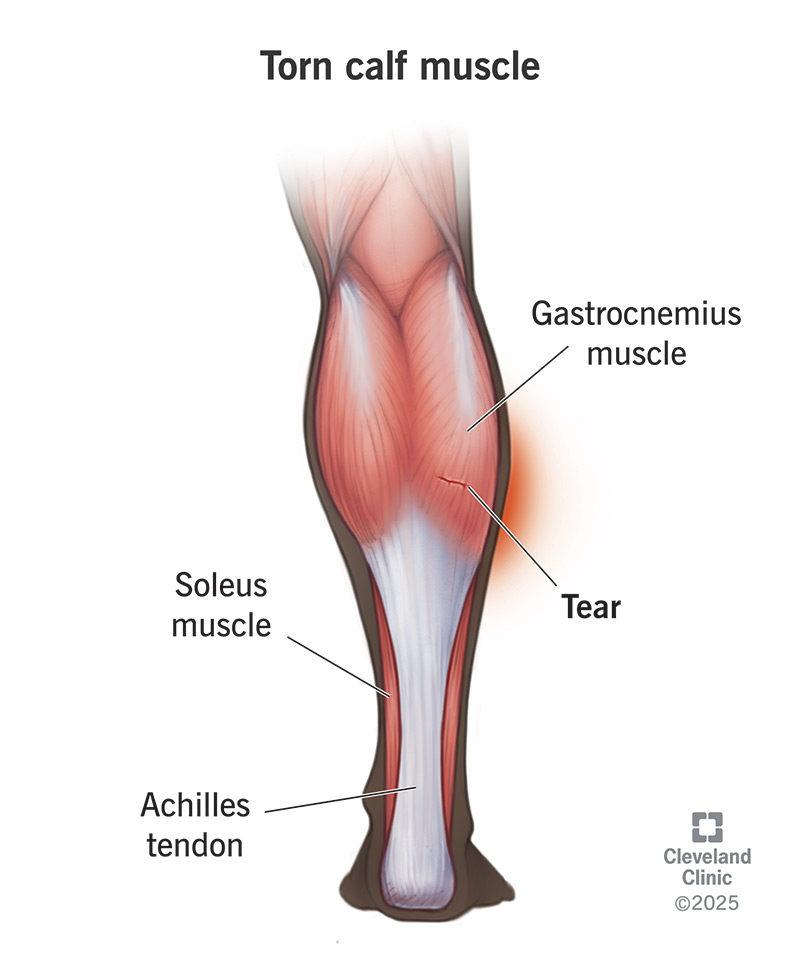A torn calf muscle is a painful injury in the muscles behind your shin bone. Athletes and people over 40 are especially prone to this type of muscle injury. Calf muscle tears usually heal after a few weeks of conservative treatments, like rest, ice, compression and elevation. In rare cases, you may need surgery.
Advertisement
Cleveland Clinic is a non-profit academic medical center. Advertising on our site helps support our mission. We do not endorse non-Cleveland Clinic products or services. Policy

A torn calf muscle, or calf muscle tear, is a severe calf strain, an injury that occurs when you overstretch a muscle in your calf. Your calf muscles (the gastrocnemius and soleus) are in your lower leg, behind your shin bone. They extend from behind your knee down to your heel. These muscles can tear if you perform sudden movements that severely overstretch them. Calf tears can be partial or complete (rupture).
Advertisement
Cleveland Clinic is a non-profit academic medical center. Advertising on our site helps support our mission. We do not endorse non-Cleveland Clinic products or services. Policy
Your calf muscles are at especially high risk for tears because of their location between two joints — your ankle and your knee. These muscles also have very tight muscle fibers, making them prone to overstretching injuries. If you develop severe or sudden calf pain, contact your healthcare provider. They can evaluate your injury and determine appropriate treatment.
Calf tear symptoms may include:
A ruptured calf muscle can happen if you suddenly overstretch your calf. Quick pivots, jumps or abrupt stops during sports can cause this injury. It’s also possible to develop tears over time if you overwork your muscles. People who return to exercise too quickly after a previous calf injury can also develop tears.
Anyone can get a ruptured calf, but it’s most common in:
Advertisement
In very rare cases, ruptured calf muscle complications may include:
Your healthcare provider will perform a physical exam and review your symptoms. They may palpate (press on) your calf muscles to check for areas of tenderness or swelling.
Sometimes, gastrocnemius tears look like other injuries in your lower leg, like:
Your provider might require additional tests when the diagnosis isn’t clear.
Your healthcare provider may perform imaging exams to evaluate your muscles:
After confirming you have a calf muscle tear, your healthcare provider may recommend a home treatment known as RICE:
Until your provider says it’s OK, don’t:
Muscle tear treatment may also include the use of a soft cast or boot. Some people need crutches or an assistive device to move around as their injury heals.
After several weeks of RICE, your provider may recommend physical therapy. Therapy can help you regain strength and flexibility in your calf muscle. It can also help you get back to everyday activities, like walking up stairs or pressing down on the gas pedal in your car with less pain.
You may need surgery for a ruptured calf muscle if you:
Contact your provider if you have symptoms of a calf muscle tear, including if you:
Most people recover fully from a calf muscle tear within a few weeks or months, depending on the severity of their injury. Although rare, some people continue to experience prolonged calf pain even after their injury heals.
Advertisement
It’s important to note that even once a ruptured calf muscle heals, there may be scar tissue in the muscle. That tissue isn’t as strong as the surrounding muscle. This puts you at a higher risk for future torn calf muscles and other injuries in your lower leg.
You can reduce your risk of a calf muscle tear by:
Torn calf muscles are a common injury that affects not only professional athletes but anyone who participates in certain sports and other physical activities. This painful injury can put you on the sideline. So, reach out to your healthcare provider. While mild injuries may heal with rest, ice and other nonsurgical treatments, only your provider can determine if you’ll require something more to get you on your way.
Advertisement
From sudden injuries to chronic conditions, Cleveland Clinic’s orthopaedic providers can guide you through testing, treatment and beyond.

Last reviewed on 07/08/2024.
Learn more about the Health Library and our editorial process.